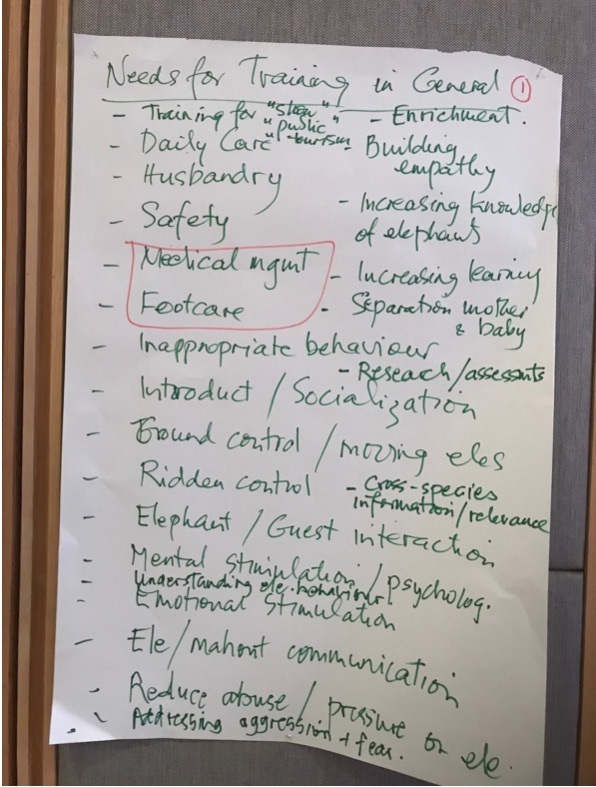The first day of this meeting began with a presentation from John Roberts on what ACEWG is all about. We all introduced ourselves and then began a discussion on the need throughout Asia to improve the welfare of the Asian elephant. I began to realise very quickly how heavily outnumbered I was in this room from my standpoint. Of the people directly involved with elephants at this meeting, most were either vets or zoo-based trainers who go to Asia to teach target training and who work in protected contact (i.e. from behind a wall). What we do with HELP is very unique because we work in a free contact (directly with the elephant) situation.

The ACEWG group focuses on improving conditions for captive elephants which account for a third of Asian elephants
We heard via the grapevine that there was an expectation that we would all end up disagreeing with each other especially between HELP’s approach and the approach of the target trainers. I networked with the target trainers and we found common ground so that when we arrived at the meeting the next day we were able to support the work of each other which is most important, because there is no strength in splintered ideologies that mostly share common ground. The main difference however between our two approaches is that HELP’s work is more holistic in that we train mahouts to train and interact with their elephants in a more safe and efficient way both on the ground and where relevant, when riding the elephant as well as dealing with all manner of behaviour problems in the free contact situation with a large array of techniques including various desensitisation techniques. On the other hand, the target training people work in protected contact and utilise positive reinforcement where they train the elephant to move toward and touch a target with a specific and targeted body part and they use this method as the solution for all behaviour problems. For example, if an elephant showed resistance to having its eye touched by a human, HELP would use the counter conditioning technique which utilises positive reinforcement whereas the target training group would train the elephant via target training to move its eye toward the human. Both techniques are valid.
The next day we had further discussions about specific aspects of training and welfare and with the aim to teach the non-trainer delegates to understand the differences and fundamental similarity in terms of learning theory, between the various training approaches. From my perspective I wanted them to recognise that even the zoo trainers and ourselves come from the very same place in that we use learning theory as the basic framework of our work but there are many roads to Rome in the techniques that are used. Following this, there was a Council meeting of ACEWG and as I’m not a member of this group, (my membership is of the IUCN-based Asian Elephant Specialist Group, the AESG) I left the meeting.

Some of the points raised about current training needs
The following 2 days were set aside for trainers to form a specific Asian Elephant Training group and formalise this. We did just that and we formed the unwieldly named Asian Elephant Behaviour Management Working Group (AEBMWG). As time goes on will probably change our name into something like the International Asian Elephant Trainers Association.
This meeting spanned two days and we spent much time setting up a framework for this group that included a mission statement, vision, objectives and outputs. Because there were 5 zoo-based target trainers and only myself from HELP, I emphasised the clear distinction between the protected contact training of the target trainers where they worked behind a three- or four-sided wall for safety’s sake and outside their target training framework they do not train the mahouts to implement combined reinforcement for their 24/7 interactions whereas HELP’s work is in free contact and we focus on training the mahouts on how to train their elephants in a more humane and efficient manner in all their interactions with their elephants using combined reinforcement.
The target trainers showed surprise that HELP works in free contact however I explained that using very subtle tactile pressures that induce an immediate correct response that in turn is reward by positive reinforcement as well as the termination of the tactile reinforcement very quickly makes the elephants calm and in all our years of doing this in 5 countries we have never encountered and aggression in training. My biggest concern is that outside of the training wall, if the mahouts are not trained to reconfigure their training and abandon punishment that, regardless of method, the elephants will still be subject to injury and pain and are likely to become aggressive. In fact, we have seen in such scenarios recent injuries where the mahouts are using their ankuses on the animal and with visible and recent wounds on the head and ears. What I learned from meeting this group and hearing in detail of their methodologies, that HELP’s work is critical. Therefore, the work outside the target training pen is paramount and would greatly assist the elephants to be calmer at the outset for the target training.
I am grateful to all our donors for their support in enabling me to obtain a clearer picture of the current new wave of elephant training in SE Asia and as I mentioned it highlighted HELP’s relevance more than ever.